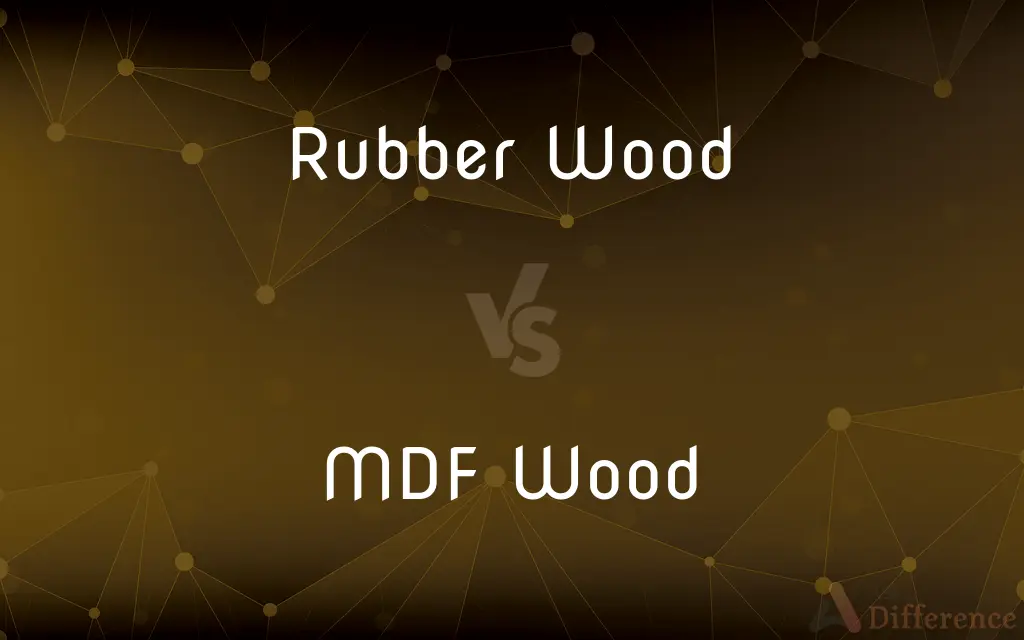Rubber Wood vs. MDF Wood — What's the Difference?
By Tayyaba Rehman — Published on November 14, 2023
Rubber Wood is a hardwood from rubber trees, while MDF Wood is an engineered wood made from wood fibers and resin.

Difference Between Rubber Wood and MDF Wood
Table of Contents
ADVERTISEMENT
Key Differences
Rubber Wood is derived from the Pará rubber tree, primarily grown in tropical regions. This tree produces latex, which, when harvested, leaves behind wood suitable for furniture-making. MDF Wood, on the other hand, stands for Medium-Density Fiberboard, an engineered wood product made from broken-down hardwood and softwood residues combined with wax and resin binders.
Rubber Wood is recognized for its durability and sustainability. When latex production decreases, instead of discarding the trees, they are repurposed for lumber. MDF Wood, meanwhile, makes the most of wood waste by reconstituting it into sturdy panels, minimizing waste and ensuring efficient resource use.
In terms of appearance, Rubber Wood has a pale yellow to creamy hue with a straight grain, lending it a natural wood aesthetic. MDF Wood, because of its manufacturing process, doesn't have a grain and is typically smooth, which is why it's often veneered or painted to enhance its appearance.
For applications, Rubber Wood is commonly used in furniture making due to its strength and ease of working. MDF Wood, with its uniform surface, is perfect for cabinetry, moldings, and doors, especially when a smooth finish is desired.
Lastly, when it comes to environmental impact, Rubber Wood is often considered eco-friendly since it makes use of trees that have completed their latex-producing cycle. MDF Wood, while resourceful, does use resins that can emit formaldehyde, although many modern MDF products are made with low-formaldehyde resins.
ADVERTISEMENT
Comparison Chart
Origin
From Pará rubber trees
Engineered from wood fibers and resin
Appearance
Pale yellow to creamy with a straight grain
Smooth and lacks grain
Common Use
Furniture making
Cabinetry, moldings, doors
Environmental Impact
Eco-friendly (repurposed after latex production)
Uses wood waste, but may emit formaldehyde
Durability/Sturdiness
Durable and sturdy
Sturdy but can be prone to swelling in moisture
Compare with Definitions
Rubber Wood
A durable material commonly used for crafting quality wooden items.
The bed frame, crafted from Rubber Wood, promised years of durability.
MDF Wood
An engineered wood made by combining wood fibers with resin binders.
The artist chose MDF Wood for her project because of its smooth surface.
Rubber Wood
A hardwood sourced from latex-producing rubber trees.
The table was made from beautiful Rubber Wood, showcasing its natural grain.
MDF Wood
Typically veneered or painted to enhance its aesthetic appeal.
The MDF Wood bookcase, once veneered, looked identical to a solid wood piece.
Rubber Wood
The wood harvested from mature rubber trees after their latex-yielding cycle ends.
Once the rubber trees ceased their latex production, they were cut for Rubber Wood.
MDF Wood
Medium-Density Fiberboard offering a uniform, grain-free appearance.
For a seamless painted finish, they opted for MDF Wood cabinetry.
Rubber Wood
A sustainable choice in furniture-making due to its repurposing from spent rubber trees.
Sustainability advocates often prefer Rubber Wood for their furniture pieces.
MDF Wood
A product derived from reconstituted hardwood and softwood residues.
MDF Wood panels made optimal use of wood waste, promoting resource efficiency.
Rubber Wood
Recognized for its pale yellow to creamy coloration with a straight wood grain.
The creamy texture of the Rubber Wood shelf caught everyone's attention.
MDF Wood
Known for its use in doors, cabinets, and moldings due to its smooth finish.
MDF Wood was the primary choice for the interior moldings because of its refined appearance.
Common Curiosities
What is Rubber Wood?
Rubber Wood is the hardwood harvested from the Pará rubber tree, primarily used after its latex-producing years.
How sustainable is Rubber Wood?
Rubber Wood is considered sustainable as it utilizes trees after their latex production cycle, reducing waste.
Can MDF Wood withstand moisture?
MDF can be prone to swelling when exposed to moisture, so it's important to keep it dry or use moisture-resistant varieties.
Is Rubber Wood eco-friendly?
Yes, Rubber Wood is often deemed eco-friendly since it repurposes trees after their latex-producing years.
Why is Rubber Wood often found in furniture?
Rubber Wood is durable, easy to work with, and has an attractive natural grain, making it a favorite for furniture crafting.
Where does Rubber Wood come from?
Rubber Wood is harvested from the Pará rubber tree, primarily found in tropical regions.
Is MDF Wood good for furniture?
MDF Wood is commonly used in furniture, especially when a smooth, consistent finish is desired.
What is MDF Wood?
MDF stands for Medium-Density Fiberboard, an engineered wood product made from wood fibers and resin binders.
Does MDF Wood contain formaldehyde?
While traditional MDF can emit formaldehyde, many modern MDF products are made with low-formaldehyde resins.
What's the primary difference between Rubber Wood and MDF Wood in appearance?
Rubber Wood showcases a natural wood grain with a pale yellow to creamy color, while MDF Wood is smooth without grain.
How do I maintain MDF Wood furniture?
Keep MDF furniture dry, clean it with a damp cloth, and avoid abrasive cleaners to ensure its longevity.
Is MDF Wood flammable?
Like most wood products, MDF can burn, but it's not especially flammable. It's always good to keep wood products away from open flames.
Which is heavier, Rubber Wood or MDF Wood?
MDF Wood is generally denser and heavier than Rubber Wood.
Can I stain Rubber Wood like other hardwoods?
Yes, Rubber Wood can be stained, though its natural pale color might affect the final shade.
Are Rubber Wood and MDF Wood resistant to pests?
While Rubber Wood has a natural resistance to some pests, both materials can be vulnerable and might require treatments to enhance their resistance.
Share Your Discovery

Previous Comparison
Common Law vs. Code Law
Next Comparison
Palm Oil vs. Coconut OilAuthor Spotlight
Written by
Tayyaba RehmanTayyaba Rehman is a distinguished writer, currently serving as a primary contributor to askdifference.com. As a researcher in semantics and etymology, Tayyaba's passion for the complexity of languages and their distinctions has found a perfect home on the platform. Tayyaba delves into the intricacies of language, distinguishing between commonly confused words and phrases, thereby providing clarity for readers worldwide.












































